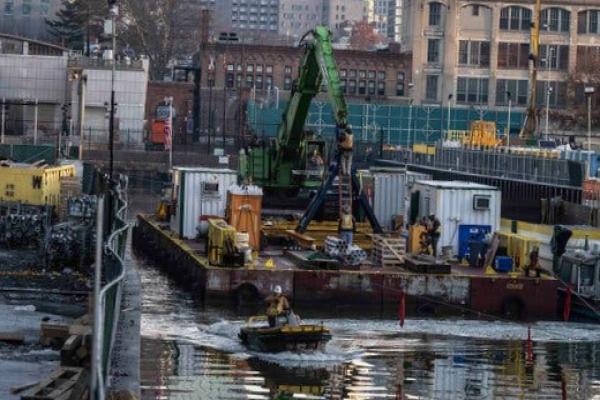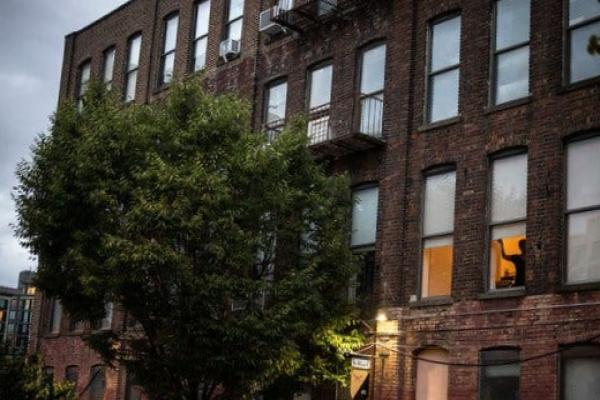New York
The unearthing of a subterranean chemical cloud has not hindered the progress
When a Real Estate Boom Came to a Toxic Corner of Brooklyn. Dozens of new buildings are going up along the famously polluted Gowanus Canal.
Updated 2024-Sep-30 02:34

A worker on a small boat in the Gowanus Canal next to a barge, with buildings in the background.
Heide Marie Dudek from the state environmental agency labeled the site as a uniquely complex issue.
State officials have informed the artists at 543 Union that testing will persist until TCE is no longer found.

A brick building with dozens of windows and a fire escape with a healthy tree full of leaves in front.
However Voice of Gowanus advocated for the elimination of all polluted soil a costly action that may involve digging hundreds of feet underground.
According to the state this is usually not needed. The main difficulty agencies are encountering is convincing property owners to consent to testing noted John Brennan an Environmental Protection Agency project manager.
If the test results exceed the state guidelines New York law requires landlords to inform the tenants.
Not all employees at a contaminated building are subject to the law. No consequences exist for a property owner who chooses not to test.
Following the discovery of high TCE levels in the lofts at the box factory state officials installed a mitigation system and conducted testing regularly.
The artists at 543 Union Street knew all about the famously toxic canal that runs next to their building a former box factory in Gowanus.
But in the decades since they converted the factory to broad timber beamed lofts the artists’ most pressing concerns were typical for a century old building in Brooklyn broken pipes hallways in need of a fresh coat of paint a perpetually damp basement.
That was before a letter arrived from the New York State Department of Health just before New Year’s Day 2023.It asked an unexpected and alarming question. Could the Health Department test the artists’ lofts for a chemical called trichloroethylene?No one in the building had ever heard of trichloroethylene or TCE but they began to wonder whether their health was in danger.
And there was another worry. Would they have to leave the building they had worked so hard to make hospitable?This is the paradox of Gowanus.
In 2010 the Gowanus Canal was listed as a national Superfund site a designation the Environmental Protection Agency uses to prioritize cleaning up the most toxic places in the country.
Yet since then Gowanus has emerged from its industrial past to become one of Brooklyn’s hottest real estate markets and is in the midst of a construction boom.
Fifty two new buildings are either under construction or are expected to be built over the next five years.
The pollutants in the canal are well documented benzene mercury chloroform vinyl chloride coal tar and efforts to clean the waterway are proceeding though years behind schedule.
But the discovery of TCE a chemical that has been linked to cancer birth defects and Parkinson’s disease revealed just how polluted the rest of Gowanus might be.
Since the spring of 2023 more than 100 buildings have been tested for TCE 21 were found to have levels of chemicals in their indoor air that required immediate cleanup.
At the box factory TCE levels were 450 times the state’s allowable guidelines. The news has rippled through the neighborhood.
Local parents in particular have become concerned: Three schools near the canal have been tested though none have shown high levels of TCE.
One of them had levels of other chemicals that require the state to take action.
A group of health inspectors would routinely come to the building inspect each studio gather air samples and assess the basement system.
Following almost a year of testing the artists at 543 Union were relieved to hear that TCE had largely disappeared from their studios.
However it remained in the unfinished basement where occasional water leaks were common in the 19th century structures prevalent in this Brooklyn neighborhood.
Removing TCE is a simple process. Machines can be set up in buildings to extract contaminated air from the basement and release it outside causing it to evaporate.
The state environmental agency has placed mitigation devices throughout Gowanus without charging property owners.
An exploration close to the shuffleboard association was found.

